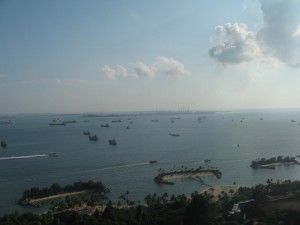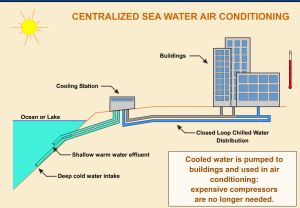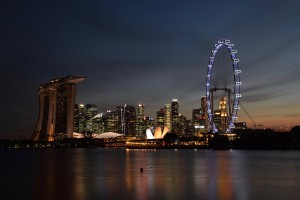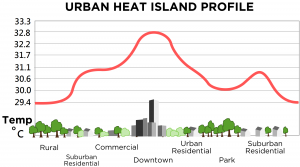Victory Speech
Calm down, calm down. Yes, I hear you. Loud and clear. Thank you my fans, I can hear you reaching out to me, yearning for me to pen another post. Sorry to keep you waiting – complicated business, complicated. Thank you very much.
Cities are great. A conglomeration of people, destined to do great things, achieve great feats together. We broke and transcended boundaries, one after another, revolution after revolution. We pushed the pinnacle of science, higher and higher. We found solutions to our solutions, papering over the cracks. Cities have allowed great minds to come together, forging a whole much greater than the sum of its parts. It is deserving of applause that we have made it thus far. Environmental issues, however, are certainly not a hoax, and it’s increasingly eminent.
So it is up to us, whether we choose to come together another time, to put to bed the elusive elephant in the room: climate change.
Ocean Thermal Energy Conversion
It is no secret that cities use up a large bulk of the energy budget. Thus sourcing for more renewable and reliable sources of energy is always important.
Ocean Thermal Energy Conversion (abbreviated OTEC), interestingly generates energy through the temperature difference between surface and deep sea waters (1).
 (2)
(2)
The idea is very similar to coal-fired power plants, where heat is used to excite a fluid, in this case it is ammonia (1), and the excited fluid moves and turns a turbine that produces energy. I have a few personal thoughts on this, and by any means I may be wrong.
It is definitely a very interesting idea. Although it is stated that hot & cold waters are respectively drawn out from the shallow and deep waters, and consequently the mixed, thermally averaged water is released back, the energy used to turn the turbines have to come from somewhere. Therefore the ocean ‘system’ actually loses energy as a whole. As there is a net loss of energy from the ocean to turn the turbines, I wonder whether, on a large scale, it is viable to possibly also conveniently mitigate the onset of rising sea temperatures & its subsequent ramifications on wildlife and habitat?
However I also question its effectiveness to produce energy. Comparing it to current coal plants, where coals is fired to produce steam, the temperature of coal can go up to almost 2000°C (3). The maximum difference in temperature between the coldest and warmest waters would be merely ~20°C. How effective will this technology be in displacing conventional fossil fuels?
In a city like Singapore, if this technology would be proven effective, I would think that this would be pretty viable for us, as we are situated right smack in the tropics, possibly having one of the highest surface sea temperatures.
So many ideas, yet so unattainable.
References
- What is OTEC –. OTEC news. Retrieved 28 October 2016, from http://www.otecnews.org/what-is-otec/
- Ocean Thermal Energy Conversion | Makai Ocean Engineering. Makai.com. Retrieved 28 October 2016, from http://www.makai.com/ocean-thermal-energy-conversion/
- Coal and Charcoal. Anvilfire.com. Retrieved 30 October 2016, from http://www.anvilfire.com/FAQs/coal.php
Seawater Body
Remember my previous post “Water Body”? Well, this is the sequel. Water Body v1.2
Seawater Body.
Water Body was all about how there are various ways to cool a city down, and I introduced a concept, Deep Water Source Cooling (abbreviated DWSC), that makes use of ponds/ reservoirs i.e. bodies of water to replace air-conditioning. I discussed a little of its limitations, but recently I read about this: Sea-water air-conditioning.
Similar to the concept of DWSC, water is drawn from the lower depths, pass it through a heat exchange unit and the warmed water is discharged and returned. MAKAI, the company marketing this system, claims that it can save 90% of the energy used in air-conditioners that rely on air compressors (1). Perfect. Furthermore we do not use up fossil fuels in this method of cooling, alleviating a host of problems like global warming and air pollution.
Remember how I criticized DWSC to be unfeasible in Singapore as we are summer all year round? Well, nature has a robust answer. Thanks to oceanic convection currents, i.e. difference in temperature between the equator and the poles that produce a huge global-scale convection, sea water will be more cool, for one, and also there’s no worry that constant discharging of warmer water will cause the temperature of the said water body to rise insidiously without decreasing, as will be the case for closed systems like ponds/ reservoirs.
Even though the deep seawater around the equator may not be as cool, MAKAI has estimated that the energy usage of this system will still be 1/4 of that of a conventional compressor air-conditioner (1). Interesting times ahead, considering Singapore is a city-island surrounded by water.
Viable? Maybe. Some places in Hong Kong for example are currently doing it. Will it happen? We never know. Considering our rampant land reclamation projects at hand, installing pipelines that restrict our ‘growth’ may not be exactly what the government has in mind.
^^cheers
References
- Sea Water Air Conditioning | Makai Ocean Engineering. Makai.com. Retrieved 15 September 2016, from http://www.makai.com/sea-water-air-conditioning/
Stop-motion
If life were stop motion, what would I be? Would I choose to live at 1 frame a second? Or 2? Would there be a difference?
If life were stop motion, would I still be able to play the games I love or talk to the people I want? Will the things I used to own feel the same to the touch? Would I be able to sense the sun caressing my face, if the frames always froze?
If life were stop motion, would a slight drizzle or heavy downpour, feel any different? Would the howling winds echo in my ears, could I savour the scent of rain?
If life were stop motion, would the fluttering wings of a butterfly be less stunning? Would a dolphin’s leap still seem so graceful?
If life were stop motion, would everything around me lose its lustre? Would I regret my choices?
If life were stop motion, will I live voraciously? Or will I be disheartened.
If life weren’t stop motion, I know, I would never, take these things for granted.
A short poem about sustainability, inspired by stop motion videography.
Solar Pond
Have you ever wondered, that people living in cities are so paradoxical? It’s hard to please us, because we, are so confusing. We want to feel cool, but when bathing, the water hot. One moment we consume iced drinks, the next minute, snuggle in our blankets, with the air-conditioning blasting while we sleep.
This generates a lot of energy wastage, from my idealistic point of view, heat energy isn’t going to where it’s needed most i.e. inefficient distribution. Recently I read up about this idea of the Solar Pond. It is not state-of-the-art technology, in fact it has been around for a few decades already. Funny that it took me this long. Nevertheless…
Like many others, it is an ingenious idea, based on simple concepts. A normal column of water naturally has its convection currents ongoing, and after a substantial amount of time untouched, it would be in thermal equilibrium.
Basically, in this tub, the base designed to be super heat-absorbing, possibly coloured black, and copious amounts of salt is added to the water residing inside. As high salinity water sinks to the bottom due to the force of gravity on density, it creates a steep salinity gradient, where the water below is saturated, while in an ideal situation the top layer is unsalted (2). As the entire pool is heated up together by the sun, convection currents do not surpass the salinity gradient, and thus heat from the bottom does not convect up and gets lost in the atmosphere (3). The figure below shows all the major processes that goes on in a typical solar pond.
The heat trapped below can be transferred and used in cities for use, and this way, harnessing the renewable energy of the sun, we cut down on fossil fuel usage and its harmful aftereffects.
An idea I can think of is possibly installing these in rooftops? Instead of wasting money on heaters and boilers, the solar pond may indeed be a solution. There seems to be however some maintenance complications, like the crystallizing of salts and eventual evaporation of the water (2), rendering this idea not too feasible, but I believe this development may only be in its infancy, and we thus have to rely on great, bright engineers, to solve these sticky issues for us.
Meanwhile, re-read paragraph 1 and REPENT!
References
-
González, D., Amigo, J., Lorente, S., Bejan, A., & Suárez, F. (2016, April 05). Constructal design of salt-gradient solar pond fields. International Journal of Energy Research Int. J. Energy Res., 40(10), 1428-1446. doi:10.1002/er.3539
- Solar Ponds Will Determine the Future of Energy Creation. Solar Energy For Homes. Retrieved 20 September 2016, from http://www.solar-energy-for-homes.com/solar-ponds.html
- Solar pond. Edugreen.teri.res.in. Retrieved 20 September 2016, from http://edugreen.teri.res.in/explore/renew/pond.htm
Urban Heat Island
Today, about half of the world population are living in major or minor cities (1), the urban heat island effect thus affects approximately 3.5billion people. Therefore though this issue may be deemed not so urgent, it is significant. I prefer to call this an effect, instead of an issue. The Urban heat island effect.
Basically cities are generally warmer than other natural landforms. It sounds really intuitive I know, but most layman attributes the increase in warmth to simply heat generated by human activity, which includes heat produced by industries, electronics that we use that generates lots of ambient heat collectively, or cars and buses, transportation. That is true, but I would also like to enlighten you about other major factors causing this urban heat island effect.
Firstly, removal of trees and vegetation to pave way for cities contribute. Trees and vegetation generally cool down the area by evapo-transpiration. Thus removal of such greenery diminishes the efficacy of natural heat dispersion.
Secondly, thermal properties of human construction are also a main cause. Roofs make up about a quarter of exposed surface land in cities (2). Furthermore roads and buildings that cover much of the rest of the land area usually have high thermal absorption and low albedo, trapping heat within the city.
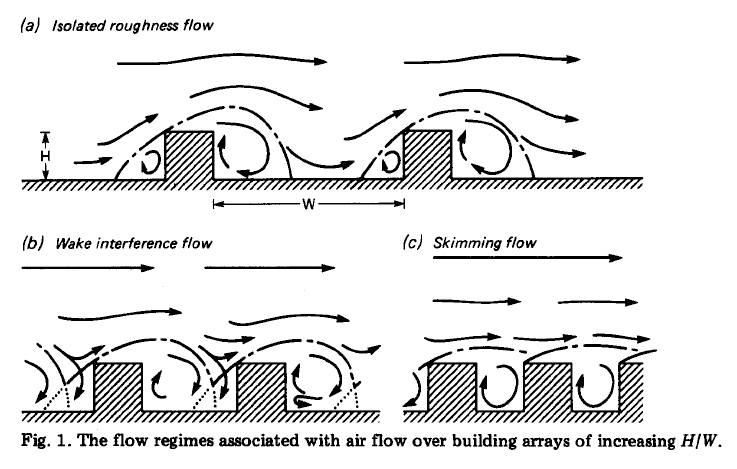 (3)
(3)
Also tall buildings are tightly packed in and within the city area, contributing to another phenomena called Urban Canyon. Simply put these high rise redirect winds flowing overhead and trap them into small vortices between buildings. This also vastly reduces the wind speed and consequently the capacity to dissipate heat out of the urban area. (3)
UHI may be unhealthy, not just skin deep, but ozone has been shown to favour warmer temperatures (4) and thus a cloud of ozone may form over urban areas. Ozone in the stratosphere is the “good” ozone that absorbs and reflects harmful UV rays, however ozone in the troposphere, which is what is directly above us, is bad, as it is toxic. Also increased temperatures may prove detrimental to the already scarce wildlife present in cities.
Also what happens if the city gets hotter? We turn on the air conditioner! Bravo. Everything seems to be somehow related to global warming, energy wastage and un-sustainability!
Some countries and buildings have noticed this problem and thus implemented various town planning and building initiatives that include roof gardens, or more parks and lakes, generally green areas and water bodies to curb the heat. This is great and I am grateful that authorities are taking notice of this.
Well, who doesn’t like greenery?
References
- Human Population: Urbanization. Prb.org. Retrieved 28 September 2016, from http://www.prb.org/Publications/Lesson-Plans/HumanPopulation/Urbanization.aspx
- Susca, T., Gaffin, S. and Dell’Osso, G. (2011). Positive effects of vegetation: Urban heat island and green roofs. Environmental Pollution, 159(8-9), pp.2119-2126. Retrieved from: http://www.sciencedirect.com.libproxy1.nus.edu.sg/science/article/pii/S0269749111001539
- Urban Street Canyons. Web.mit.edu. Retrieved 28 September 2016, from http://web.mit.edu/nature/archive/student_projects/2009/jcalamia/Frame/05_canyonwind.html
- Ozone an Added Health Concern in Urban ‘Heat Islands’. Wpsdlocal6.com. Retrieved 28 September 2016, from http://www.wpsdlocal6.com/story/6781504/ozone-an-added-health-concern-in-urban-heat-islands
Urban Cowboy
My love for urban, cities and philosophy has been well documented in earlier posts. Today albeit a slight change, the topic of Urban Cowboy.
So what’s the difference between rural cowboys and urban cowboys? Well aplenty. Firstly, rural cowboys are more common in North America in the 1700s and urban ones closer to the 20th century. Secondly their range(pun unintended) of work are dissimilar, rural cowboys usually rear cattle with brown or white hide of the subfamily Bovinae while urban…. .. ohh kay that’s enough nonsense for today.
Thank you for spending time reading the abstract above, your feelings have been toyed. In fact, Urban Cowboy is a film in 1980 starring John Travolta and Debra Winger. An American romantic drama film headlining a love hate relationship. What stood out from this film was not its romance in my opinion, though still a better love story than twilight. Its music was pretty well done, I’m not sure they called it OSTs in those days.
 (2)
(2)
A few of those songs turned out to be classics. Stand By Me – Mickey Gilley. This piece of music is still ubiquitous even in my generation. How about the song ‘Could I have this Dance’ by Anne Murray. Country music fused with a bit of pop flavours, these two songs are gentle on the ears, with slow tempo, simple composition and vocal harmonies. Nothing fancy, no complex chords or rhythms, and steady dynamics. Probably the kind of music that puts millenials to sleep. Music indeed has the power to connect people and till this day, last-generation songs are still celebrated and even remixed into new compositions.
Something seemingly irrelevant, like a film, is able to move people and transcend cultures. It can connect people, and give people a sense of place and identity. Just like how in 2016 K-dramas have proliferated the world, and created so much new culture, and has put so much new meaning into places. e.g. Nami Island in Korea only started flooding with tourists after the series Winter Sonata. Film is indeed powerful. Urban cowboy, 1980, too fuelled an urban cowboy syndrome (1), making popular mechanical bull riding in those days.
Irrelevant? You ask. I beg to differ. In densely populated areas such as cities, maybe film and environment could work hand in hand. Maybe we could inspire others through film. Maybe we could create identity, culture, and meaning. Just maybe, I could be the director of the next hit film, Urban Cow Deaths.
^^cheers
References
- Green, R. S., & Maier, R. (2003, December). The urban cowboy syndrome revisited: case report. Southern Medical Journal, 96(12), 1262+. Retrieved from http://go.galegroup.com.libproxy1.nus.edu.sg/ps/i.do?p=AONE&sw=w&u=nuslib&v=2.1&it=r&id=GALE%7CA111927756&sid=summon&asid=769c910706f45787ccf514c9a3435ad2
- Urban Cowboy [Photograph] (1980) Retrieved from: http://www.imdb.com/title/tt0081696/mediaviewer/rm1382735360
oh, well… well…
Morning! A pensive quote here to start your day.
“I sometimes think that people’s hearts are like deep wells. Nobody knows what’s at the bottom. All you can do is imagine by what comes floating to the surface every once in a while.”
-Haruki Murakami, Blind Willow Sleeping Woman
Fret not, I’m not about to ramble and whine about depleting groundwater, aquifers or tarmac. Doing so would be guilty of defiling this beautiful piece of writing. The analogy writer Murakami adopted is purely amazing and KISS. (Keep It Short and Sweet.) The language is simple, but lovely. It makes me wonder how ignorant and helpless we actually are, it is never possible to completely understand someone. At the very best we empathise, and even then who can fully understand how I’m feeling? As it has been said, everybody has three faces. The first, you show to the world. Second, to your close friends and family. The third face, you never show anyone. It is the truest reflection of who you are. However deep wells though are particularly dangerous and unsustainable in a sense they forsake the long term well-being and sustainability for the short term (1). My apologies for the mood spoiler, had to add that in lest this post becomes a romance novel.
It is uncanny how physical and emotional things can link up so well. People’s hearts can be likened to deep wells. Facades that we show the world akin to the water that floats up from beneath the well, contaminated by Arsenic or not, hopefully. yet. Staring down a deep well, all you can see is a hollow darkness. The same way, looking at someone from the outside, what we can understand about her is nothingness.
Groundwater pollution in less developed cities is a real issue. Especially to those ignorant of the harmful effects, they may choose to exploit this resource by mistake. This is not a technical blog post, and i shall not ride you with details, but jokes and laughs aside, assuming business as usual, they would eventually have to face (pun intended) the consequences.
P.S. This cheerless and gloomy text kinda reminded me of a picture i saw on SGAG a while back.

References
- Winkel, L., Trang, P., Lan, V., Stengel, C., Amini, M., Ha, N., . . . Jury, W. (2011). Arsenic pollution of groundwater in Vietnam exacerbated by deep aquifer exploitation for more than a century.Proceedings of the National Academy of Sciences of the United States of America, 108(4), 1246-1251. Retrieved from http://www.jstor.org.libproxy1.nus.edu.sg/stable/41001846
- Denise Smith [photograph] Retrieved from: http://www.memes.com/img/733998
Water Body
Ever wondered why you feel more comfortable strolling beside ponds or water bodies in the city? You’re right. Large bodies of water do indeed instill a sense of peace and calm. However, what’s less known is that there is indeed science behind this occurrence. Well, in hot & humid Singapore, anywhere else feels better than the sweltering afternoon outdoor, and a mosquito-free pond fits in that description. Don’t say I told you to jump in.
It actually is really simple, exactly like how land and sea breezes work. In the day, the land heats up way faster then the pond, generating a convection current in the air above: pond breeze. The converse happens when the land cools faster than the pond (1). How ingenious. *clap clap clap
These are all more sustainable methods of cooling, compared to air-conditioning. Promoting these water bodies around the area thus improves ventilation, and whisks heat away, providing for a clean, comfortable stroll for you.
Similarly, there are also other concepts that can be used to cool an area down, that isn’t energy-sapping air-conditioning. One example would be the Deep Water Source Cooling concept. Apparently it’s energy usage is a lot lesser, about one order of magnitude lower (2).
How it works is basically as such: in colder countries, bodies of water are generally thermally stratified, and the deep waters are usually consistently around 4°C. So cool water is pumped up from about 50m deep, and it flows along pipes and into a heat exchange unit (2). The city is thus cooled. This concept is brilliant, but it has some limitations that I can think of. Firstly, it is impossible in Singapore, as we only have summer, and our rivers are definitely >4°C even at the bottom. Secondly cooling your room means warming up the pond. This may result in possible negative spin-offs for the natural habitat. Nevertheless, it is still a possible alternative that is feasible in many many parts of the world.
The next time you walk down the breezy boardwalk, don’t forget to thank all these physical processes working for you behind the scenes. ^^
References
- Sea Breezes:a result of uneven surface heating. (2010). Ww2010.atmos.uiuc.edu. Retrieved 10 September 2016, from http://ww2010.atmos.uiuc.edu/(Gh)/guides/mtr/fw/sea/htg.rxml
- Waldron, L. (2006). Deep Water Cooling | CRC Research. Crcresearch.org. Retrieved 10 September 2016, from https://crcresearch.org/case-studies/case-studies-sustainable-infrastructure/energy/deep-water-cooling
